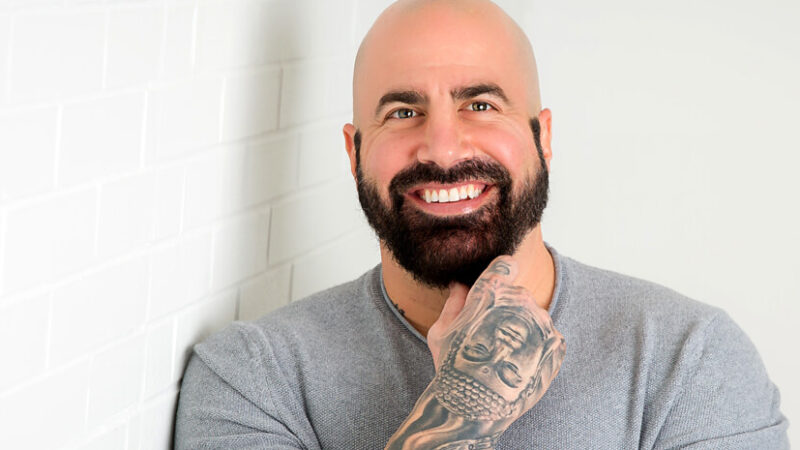-
E91: Allowing Life to Remove Your Blockages
Michael Singer — July 2, 2025
The foundational flaw in human behavior is the belief that "I'm not okay." What follows is the...
-
Cyndi Dale: Becoming Your Own Best Ancestor
Cyndi Dale — July 1, 2025
On the surface, it appears as though the lives we live proceed forward moment by moment in a...
-
Honey Tasting Meditation: Build Your Relationship with Sweetness
There is a saying that goes “hurt people hurt people.” I believe this to be true. We have been...
Written by:
Amy Burtaine, Michelle Cassandra Johnson
-
Many Voices, One Journey
The Sounds True Blog
Insights, reflections, and practices from Sounds True teachers, authors, staff, and more. Have a look—to find some inspiration and wisdom for uplifting your day.
Standing Together, and Stepping Up
Written By:
Tami Simon -
The Michael Singer Podcast
Your Highest Intention: Self-Realization
Michael Singer discusses intention—"perhaps the deepest thing we can talk about"—and the path to self-realization.
This Week:
Cyndi Dale: Becoming Your Own Best Ancestor -
Many Voices, One Journey
The Sounds True Blog
Insights, reflections, and practices from Sounds True teachers, authors, staff, and more. Have a look—to find some inspiration and wisdom for uplifting your day.
Take Your Inner Child on Playdates
Written By:
Megan Sherer
600 Podcasts and Counting...
Subscribe to Insights at the Edge to hear all of Tami's interviews (transcripts available, too!), featuring Eckhart Tolle, Caroline Myss, Tara Brach, Jack Kornfield, Adyashanti, and many more.
Most Recent
Christopher Willard: How We Grow Through What We Go Th...
Most of us are familiar with the concept of post-traumatic stress. Fortunately, there’s another way we can respond to extreme adversity. This is what researchers call post-traumatic growth—and it’s something we’re all biologically “hardwired” to access, to turn even our most difficult experiences into a source of resilience and strength.
In this podcast, Tami Simon speaks with clinical psychologist and author Dr. Christopher Willard about “how we grow through what we go through”—which is also the title of his new book. Tune in as they explore how meditation can literally be lifesaving; avoiding the trap of spiritual bypassing; the “10,000 joys and 10,000 sorrows” of our lives; embodiment practices and nervous system self-regulation; mindfulness and the capacity to respond rather than react; the practice of stretching the breath; acting ourselves into a new way of thinking and feeling; how there are many ways to healing and recovery—and finding the best for yourself; the power of posture; the connection between self-compassion and personal transformation; the practice of putting your hand on your heart; becoming a source of co-regulation for others; the concept of downstream and upstream reciprocity; and more.
Miranda Macpherson: The Transforming Power of Ego Rela...
Many of us struggle to truly live what we believe spiritually. What if closing that gap wasn’t about trying harder, but something quite the opposite? “Through the practice of ego relaxation,” teaches Miranda Macpherson, “we can stop trying to beat ourselves into spiritual shape and yield instead to an unshakable presence within.”
In this episode of Insights at the Edge, Tami Simon speaks with Miranda about taking a more feminine approach to spiritual seeking and why that involves creating an atmosphere of unconditional love. Miranda explains ego relaxation, her unique process of letting go of all the qualities that maintain the illusion of being separate from the rest of existence. Considering the roles of trust and vulnerability on the spiritual path, Tami and Miranda discuss what it means to be a channeler of grace. Finally, Miranda leads us in a guided practice for discovering the mountainous presence already available in each moment.
Christian Conte: Healing Conflict: Listen, Validate, T...
How do we fully meet and support someone experiencing emotional distress—anger, in particular? In this episode of Insights at the Edge, Tami Simon talks with Dr. Christian Conte about his Yield Theory of emotional management, focusing on the process of “listen, validate, and explore options.” Dr. Conte explains the events that led to his interest in anger management, as well as the origins of Yield Theory. He emphasizes the importance of meeting others where they are, giving them the opportunity to drain anger’s charge from their limbic system. Dr. Conte and Tami discuss why it’s necessary to cultivate humility and how Yield Theory might be applied to our currently divisive culture. Finally, they speak on the “cartoon world” that angry responses often create, as well as the importance of watching what we add to our minds.
Customer Favorites
The Way of the Feminine to Save the World
You feel special. Sometimes this feels like a curse. Like no one will understand you. Ever. Like you will always be an alien walking among regular humans, pretending to blend in. You have learned to live with this gulf, but what you really crave is community. You long to belong to the human family. To Mother Earth.
Participating in the human condition can be bewildering. It is just not always cozy and easy—rather, it’s humbling at best, downright humiliating when it is not flowing. It can seem so much simpler to ride solo, slaying your own dragons and singing the ballads you wrote about yourself. Collaboration can be tedious, and the prevailing masculine value system may have conditioned you to feel like you are giving away your power when you share it with others.
So what? Give it away. The time of the singular sage bestowing his unique wisdom is over. That was a method devised by the men in charge who sought to regulate wisdom. They taught us to suffer alone in the desert for forty years, collecting our insights in a secret box called “Esoteric Knowledge.” Then, we were supposed to dispense those insights stingily to those who proved themselves worthy by also suffering alone for the requisite forty years in the desert.
It turns out that the world is filled with special beings, grappling our way through the anxiety of solitary conundrums and tasting the occasional reprieve of connection. When you realize this, your body lets out its breath and relaxes. The curse lifts. You come in from the cold. You hold out your cup, and some other special being fills it with sweet, milky tea spiced with fragrant herbs. You drink.
Our way, the way of the feminine, is to find out what everyone is good at and praise them for it and get them to teach it to one another. Maybe you know something about the hidden meaning of the Hebrew letters, or how to build a sustainable home from recycled tires and rammed soil, or loving-kindness meditation. You, the one who knows the Islamic call to prayer, climb this minaret and call us all to prayer. You, the one who knows how to sit quietly at the bedside of the dying, show us the way to bear witness. You, the one who knows how to get us to wake up to the shadow of privilege, please wake us the #*#@ up. It will be chaotic, all this community building, but your cooperation will save the world.
Besides, it will be fun.
James Finley: Breathing God
Tami Simon speaks with Jim Finley, a master of the Christian contemplative way and a renowned retreat leader. Jim left home at the age of 18 and studied at the Abbey of Gethsemani with Thomas Merton for six years. He’s a clinical psychologist in Santa Monica, California, and the author of Christian Meditation and the book The Contemplative Heart, as well as the Sounds True audio learning programs Christian Meditation, Thomas Merton’s Path to the Palace of Nowhere, and along with medical intuitive Caroline Myss, the audio program Transforming Trauma. Jim discusses embracing our brokenness and the attitude of nonjudgmental compassion, the value of spontaneous moments of meditative awareness, and false perceptions about the practice of meditation. (56 minutes)
Unwinding Trauma and PTSD: The Nervous System, Somatic...
The mind-body connection is still a new concept in Western medicine. Descartes’s declaration “I think, therefore I am” encouraged many to view the mind as separate from and superior to the body… for almost 400 years! So, to understand the discovery of feedback loops in the nervous system linking body and mind is to undergo a major paradigm shift, with radical implications for how we view and treat conditions like trauma and PTSD—and how you can empower yourself around your own healing journey.
Why Embodiment Decreases for Trauma Survivors
Until trauma survivors feel their safety has been truly restored, their nervous system relies on defensive mechanisms like dissociation, numbing out, or immobilization. This can feel subjectively like becoming a two-dimensional “stick figure” energetically, with a body that’s barely there.
If you feel like you’re not really inhabiting your body, know that it’s not your fault and you probably had very good historical reasons to leave it. With recent advances in mind-body therapies and somatic psychology, however, there are many ways—when you’re ready—to safely return to experiencing your fully embodied self.
Perhaps the most popular of these therapies is Somatic Experiencing®.
What Is Somatic Experiencing?
Somatic Experiencing is a form of therapy originally developed by Dr. Peter Levine. It proceeds from the premise that trauma is not just “in your head.” Though you may feel off-kilter psychologically in the wake of trauma, you’re not “crazy”—you have a nervous system that has been put into overdrive.
The body can’t distinguish physical trauma from mental or emotional trauma, and this leads the brain, once you’ve had trauma, to get stuck in a state of believing that you’re in perpetual danger.
Without a way to shake off the effects of having been in a dangerous situation in the past, trauma survivors disconnect from their bodies; the trauma gets “frozen” inside. With this frozenness in the body, your emotions can become dysregulated easily; you might at times feel spacey, agitated, depressed, panicky, collapsed—or all of the above.
Again, it’s not your fault that any of this is happening: dissociating and numbing are a natural defense mechanism. Still, it may take some work, often within a therapeutic container, to start to “thaw” the frozenness or unwind the trauma.
Somatic Experiencing practitioners help clients increase their awareness of their kinesthetic, embodied experience, and lead them through techniques to gradually release stresses that have been locked into the body. Allowing both physical responses and emotions to come through, bit by bit, restores psychological balance and can help resolve even long-term PTSD.
How It All Works: Polyvagal Theory
Neuroscientist and psychologist Dr. Stephen Porges synthesized Polyvagal Theory as a way to explain human behavior in terms of the evolution of our autonomic nervous system. It not only provides a biological frame for parts of Somatic Experiencing, it has helped therapists develop a host of somatically attuned interventions and refined the way they interact with clients.
The centerpiece of Polyvagal Theory is the vagus nerve. This long nerve mediates what Porges calls the “social engagement” system. The vagus nerve’s ventral branch supports social engagement: a calm and playful, pro-social state. Its dorsal branch supports the opposite: immobilization (characterized by dissociation, depression, numbness, or “freeze.”)
If you undergo a trauma, the dorsal branch of the vagus nerve activates a state of immobilization. On the other hand, when you feel safe and embodied, your parasympathetic nervous system functions smoothly and you can (ideally) engage socially. What makes all this possible is neuroception, perception that takes place without our conscious awareness, tipping us from safety into other modes, like fight, flight, or freeze.
Clinicians trained in Polyvagal Theory support clients in making shifts in their autonomic responses, from “freeze” and shutdown to fight or flight—to safety—in order to restore a healthy range of responses and the feeling of being safe.
Practicing co-regulation with their clients helps the clients to re-establish inner safety and other positive feeling states.
How You Can Increase Your Embodiment
Trauma severs us from our body, and embodiment brings us back.
Embodiment practices like somatic therapies, qigong, and various athletic activities are some of the best medicine around for the nervous system. Even just taking a long walk while paying attention to your feet making contact with the earth can be quite supportive.
Sounds True also has created The Healing Trauma Program to offer support for your healing. The course has a faculty of 13 esteemed trauma experts—including Somatic Experiencing founder Dr. Peter Levine, Polyvagal Theory expert Deb Dana, Dr. Gabor Maté, Konda Mason, Thomas Hübl, and many others. The program takes place over nine months and is truly an immersion into the world of trauma recovery, with teachings, guided practices, live practice sessions and Live Q&As. Find out more about The Healing Trauma Program.






